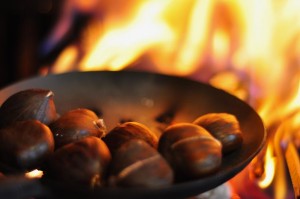
“Chestnuts Roasting On An Open Fire”
Before you roast those chestnuts in your fireplace, chimney maintenance should be a top priority for safety in your home every year.
Don’t skip the chimney sweep and fireplace maintenance. A chimney sweep uses large, stiff brushes and other tools to dislodge creosote and soot from the interior of the chimney which build up with each use of your fireplace.
Depending on how frequently you use your fireplace, as a rule, experts say if you use your fireplace regularly (averaging twice a week through the cold months), you should have your chimney cleaned at least once every two years by a qualified and trained professional. The Chimney Safety Institute of America at http://www.csia.org is the go-to authority for finding a qualified sweep. Simply use their easy search feature.
And, when you need a home inspection, call Buy Your Side Home Inspections. We have been inspecting homes and businesses in Central Florida, and specifically Osceola County, for many years. 407.780.0911.
Read More

DIY Projects That Won’t Break the Bank
You don’t need to tap into your life savings or spend the kids’ college fund to increase the appeal of your home. If you’re considering selling your home or just want to increase the enjoyment of your investment, there are several projects you can do yourself that are relatively inexpensive and are a great return-on-investment. Your local home improvement store offers free advice if you have questions.
Here are just a few suggestions.
In Your Kitchen:
- Add or update the hardware on cabinets and drawers. Shop your local hardware and home improvement stores and stick with styles that have wide appeal.
- Install a tile backsplash or paint it with an accent color. This is one of the quickest and easiest ways to update your kitchen.
- Show off the inside of your glass door cabinets by painting the back inside wall with an accent color.
- Shed some light on your meal prep with battery-powered LED undercabinet puck lighting.
- Update an old fridge with a faux stainless-steel painted finish.
- Make your cabinets feel like royalty with crown molding at the top.
In Your Bathroom:
- Remove dated fixtures and swap out lighting fixtures, faucets and handles.
- Lean a painted wood ladder against a bathroom wall to use as a towel rack and increase the space.
In Your Interior:
- Paint your interior walls with neutral colors that give the room the appearance of being larger. Start with the most visible areas of your home first and then expand your project till your entire home is painted.
- Update generic white globe ceiling mounted light covers.
- Install ceiling fans and save on your energy bill.
- Clear clutter on shelves and counters with inexpensive organization systems.
And, if you want to make sure your home is in tip top shape or you’re ready to put it on the market, call Buy Your Side Home Inspections – Central Florida’s most respected Home Inspections service. 407.780.0911.
Read More
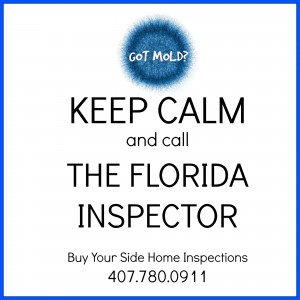
Got Mold? Keep Calm!
We often receive phone calls from distressed home and business owners that have recently discovered what they believe is mold. Mold is certainly a serious issue in Central Florida and should be investigated, but sometimes a simple phone consultation will let you know if your issues warrant an actual mold testing. After a short discussion on the phone, if we believe you may have a mold problem we will come to collect samples throughout your home, business, or commercial building in order to determine the air quality.
The mold test samples will be sent in to an independent laboratory for proper investigation. A detailed report will be sent to both you and our customer service in the office. If a mold issue is discovered, we will create a protocol to get you on the way to fixing the problem. Since we do not do mold remediation ourselves you don’t have to worry that we will recommend an unnecessary mold removal. as always, Buy Your Side is on your side! Call us today. 407.780.0911.
Read More
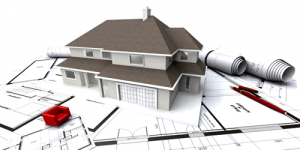
New Home Plan & Permits
You’re probably familiar with the permit requirement for new homes, mobile homes, room additions, and in-ground swimming pools. However, you may not be aware that certain additions, alterations, modifications and repairs that you or a contractor perform on your home or property require a permit.
Failing to obtain a proper permit can result in greatly increased costs, delays and even removal of structures. The 2010 Florida Building Code, Section 105.1, requires that a building permit be obtained prior to construction, alterations, repairs, and relocations. A property owner or contractor who starts work without first obtaining a permit could be subject to a penalty of 100% of the usual permit fee.
Permits are required for projects such as:
Carports, garages, fences, sheds, screen rooms, sun rooms, re-roofing, re-siding, window replacement, door replacement, garage door replacement, above-ground swimming pools, masonry fireplaces, A/C change outs, electrical work, plumbing work, and low-voltage wiring to name just a few.
Permits are not required to paint a house (interior or exterior) or to perform minor repair and replacement work on defective receptacle outlets and manual switches for lighting control.
If you are unsure whether your project requires a permit, contact Buy Your Side Home Inspections 407.780.0911.
Read More
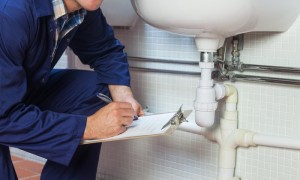
Plumbing Inspections
In the 1920’s, lead was commonly found in many plumbing systems. In fact, the word “plumbing” is derived from the Latin word “plumbum,” which means lead and was used for a long time because of its ability to resist pinhole leaks while being pliable enough to form into shapes to deliver water. When in use as a component of a waste system, it is not an immediate health threat, but as a component of potable water pipes it can be a definite health-hazard which is why homes built after 1986 incorporate lead-free products.
Plumbing systems have common components, but they are not uniform. In addition to fixtures, these components include gas pipes, water pipes, pressure regulators, pressure relief valves, shut-off valves, drain and vent pipes, and water-heating devices, some of which we do not test if they are not in daily use. The best and most dependable water pipes are copper, because they are not subject to the build-up of minerals that bond within galvanized pipes, and gradually restrict their inner diameter and reduce water volume. Water softeners can remove most of these minerals, but not once they are bonded within the pipes, for which there would be no remedy other than a re-pipe.
The water pressure within pipes is commonly confused with water volume, but whereas high water volume is good – high water pressure is not. In fact, whenever the street pressure exceeds eighty pounds per square inch a regulator is recommended, which typically comes factory preset between forty-five and sixty-five pounds per square inch. However, regardless of the pressure, leaks will occur in any system, and particularly in one with older galvanized pipes, or one in which the regulator fails and high pressure begins to stress the washers and diaphragms within the various components.
Waste and drainpipes pipes are equally varied, and range from modern ABS ones [acrylonitrile butadiene styrene] to older ones made of cast-iron, galvanized steel, clay, and even a cardboard-like material that is coated with tar. The condition of these pipes is usually directly related to their age. Older ones are subject to damage through decay and root movement, whereas the more modern ABS ones are virtually impervious to damage, although some rare batches have been alleged to be defective. However, inasmuch as significant portions of drainpipes are concealed, we can only infer their condition by observing the draw at drains. Nonetheless, blockages will occur in the life of any system, but blockages in drainpipes, and particularly in main drainpipes, can be expensive to repair, and for this reason we recommend having them video-scanned. This could also confirm that the house is connected to the public sewer system, which is important because all private systems must be evaluated by specialists.
We inspect many homes and businesses in Osceola County and we tend to see the same type issues in many of our home inspections.The most common plumbing defects include old and incompatible piping materials and faulty fixtures or waste lines. These may require simple repairs, such as replacing a fixture, or more expensive measures, such as replacing the plumbing system itself.
Buy Your Side Home Inspection provides you with an objective visual examination of the physical structure and systems of your home, from the roof to the foundation. Call us today. 407.780.0911.
Read More
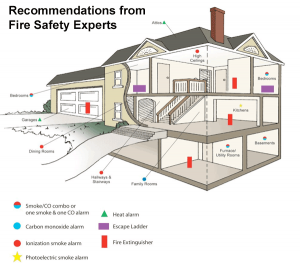
Types of Smokes Alarms
Ever wonder which smoke detector is best? Actually, there are three types of detectors available on the market according to the National Fire Protection Association and each has its advantages.
– Ionization smoke alarms are generally more responsive to flaming fires and are the kind most people have. They range between $5 to $10 a piece.
– Photoelectric smoke alarms are more responsive to fires that begin with a long period of smoldering and are $20 and up.
Combination alarms, sometimes referred to as Dual-Sensor Alarms, that include both technologies in a single device are also available for about $30 and up. It’s recommended that a combination of technologies be used in the home for the best protection. To find out what type of detector you have in your home, look on the back of the device. The fine print should say “ionization” or “photoelectric.”
Of course, any functioning smoke alarm is better than none.
Read More







Follow Us!